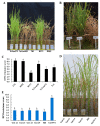Development of molecular marker and introgression of Bph3 into elite rice cultivars by marker-assisted selection
- PMID: 31086482
- PMCID: PMC6507726
- DOI: 10.1270/jsbbs.18080
Development of molecular marker and introgression of Bph3 into elite rice cultivars by marker-assisted selection
Abstract
The brown planthopper (BPH) is a serious insect pest of rice and a substantial threat to rice production. Identification of new BPH resistance genes and their transfer into modern rice cultivars are effective breeding approaches to reduce the damage caused by BPH. In this study, we mapped a BPH resistance gene to a 50-kb genomic interval between two InDel markers 4M03980 and 4M04041 on the short arm of chromosome 4 in indica rice cultivar BP60, where the BPH resistance gene was mapped in Rathu Heenati by Liu et al. (2015) and named "Bph3". This region contains two annotated genes Os04g0201900 and Os04g0202300, which encode lectin receptor kinases responsible for BPH resistance. We also developed a molecular marker "MM28T" for Bph3, and introgression Bph3 into susceptible rice restorer lines Guihui582 and Gui7571 by the marker-assisted selection (MAS) approach. The BPH resistance level is significantly enhanced in the Bph3-introgression lines, the resistance scores decrease from 8.2 to 3.6 for Guihui582 and decrease from 8.7 to around 3.8 for Gui7571. Therefore, developing molecular markers for the BPH resistance gene Bph3 and using them for molecular breeding will facilitate the creation of BPH-resistance rice cultivars to reduce damage caused by BPH.
Keywords: brown planthopper; fine mapping; molecular breeding; resistance gene.
Figures





References
-
- Cao, L.Y., Zhuang, J.Y., Yuang, S.J., Zhan, X.D., Zheng, K.L. and Cheng, S.H. (2003) Hybrid rice resistant to bacterial leaf blight developed by marker assisted selection. Rice Sci. 11: 68–70.
-
- Chen, J.W., Wang, L., Pang, X.F. and Pan, Q.H. (2006) Genetic analysis and fine mapping of a rice brown planthopper (Nilaparvata lugens Stål) resistance gene bph19(t). Mol. Genet. Genomics 275: 321–329. - PubMed
-
- Cheng, J. and Zhu, Z. (2006) Analysis on the key factors causing the outbreak of brown planthopper in Yangtze Area, China in 2005. Plant Prot. 32: 1–4.
-
- Conaway-Bormans, C.A., Marchetti, M.A., Johnson, C.W., McClung, A.M. and Park, W.D. (2003) Molecular markers linked to the blast resistance gene Pi-z in rice for use in marker-assisted selection. Theor. Appl. Genet. 107: 1014–1020. - PubMed
-
- Fujita, D., Kohli, A. and Horgan, F.G. (2013) Rice resistance to planthoppers and leafhoppers. CRC Crit. Rev. Plant Sci. 32: 162–191.
LinkOut - more resources
Full Text Sources
Other Literature Sources

